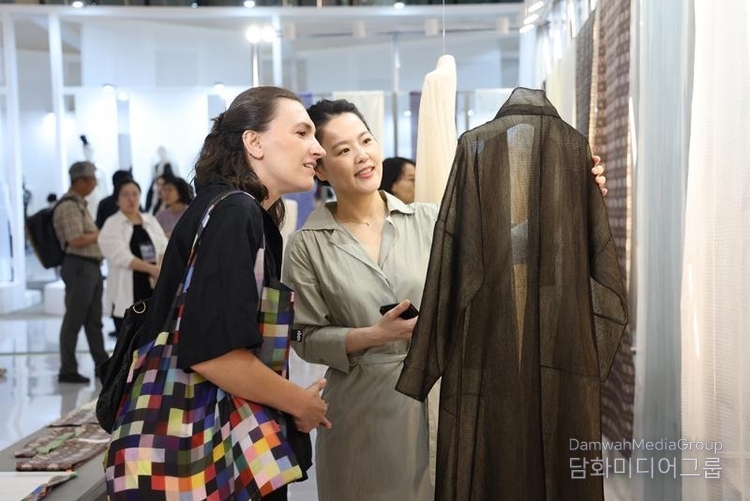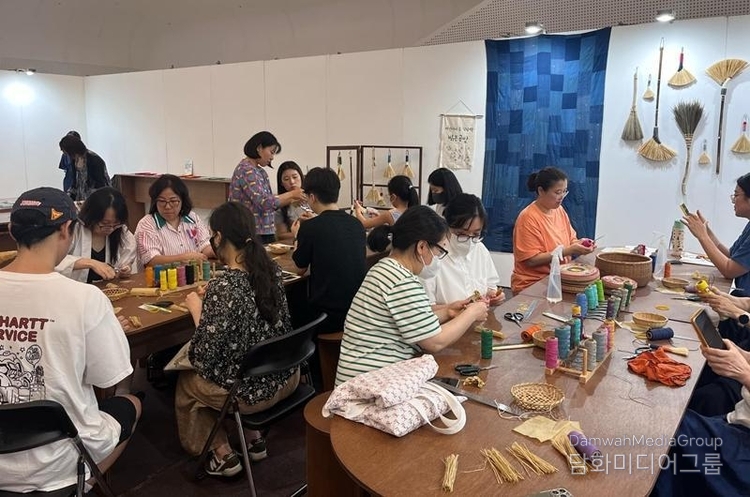By UN Journal Kayla Lee
People wearing jeans with jeogori, or a bolero-style female Hanbok (traditional attire) jacket, royal Hanbok or leather pants with hip-torn black jeogori, those carrying traditional fans and bags with traditional patterns, and even dogs clad in Hanbok.
These are part of the scenes witnessed from Dongdaemun History & Culture Station to the way to the 2024 Hanbok Expo at Art Hall of Dongdaemun Design Plaza (DDP) in Seoul’s Jung-gu District, Korea.net reported. It made one feel like the past Joseon era coexisted with the present.

Walking from Dongdaemun History & Culture Park Station on the Seoul subway to Art Hall at Dongdaemun Design Plaza (DDP) felt as if the Joseon Dynasty and the present coexisted. In addition to traditional Hanbok (traditional attire), seeing visitors expressing their individuality with their own Hanbok styles drew heavy visitor attention and admiration.
Running from Aug. 9-12, the event at DDP was jointly hosted by the Ministry of Culture, Sports and Tourism (MCST) and Korea Craft & Design Foundation.
Though normally attracting many people as the country's only expo and festival for Hanbok, the gala this year saw a far higher turnout than expected. Strong interest in Hanbok was predictable, but the event was so packed that visitors could find the venue without any signs.
According to Korea.net, a combined 112 Hanbok companies participated in this year's event to introduce new and diverse outfits. Thanks to unique creations and discounts of up to 80%, all sales booths had long lines of customers.
Hanbok in a range of designs and size attracted visitors regardless of nationality, age or gender. The expo showcased not only traditional designs but also everyday outfits such as Hanbok-style uniforms. A wide range of Hanbok products were sold ranging from outfits made with materials good for each of the four seasons, pants, shirts and leather outerwear to shoes, wallets and bags. Buyers also received free souvenirs like a bookmark made of nobang (organza or thin silk) and coasters with flowers in ink-and-wash painting patterns.

"Wow, I really love this Hanbok." This is what visitors said while passing by the entrance of the hall displaying the winners of this year's Hanbok Design Project Contest. Some repeatedly took photos of the honored works with their smartphones, Korea.net reported.
Under the theme "Hanbok Beyond Hanbok: Inheritance and Reinterpretation," the booth featured the top 30 works in this year's contest and over 100 kinds of Hanbok uniforms developed last year for the transportation and leisure service sectors.
The theme of an exhibition of tradition and modernity was "The Hidden Charm: Hanbok's Modern Revival," featuring attire not only from the Joseon Dynasty (1392-1910) but also never-before-seen clothing from earlier kingdoms such as Goguryeo (37 B.C.-A.D. 668), Unified Silla (676-935) and Goryeo (918-1392).
Another display had as its theme "Onjieum: Development and Use of Hanbok Materials," featuring a range of Hanbok fabrics of higher practicality and functionality by modernizing the weaving methods of traditional fabrics. The term "onjieum" means to correctly build the present completely based on the past.
At the interactive hall, people created their own sijeonji, or paper decorated with flowers used especially by seonbi (neo-Confucian scholars) for writing letters and poetry by trying 20 traditional types of patterned dojang (personal stamps) at the Joseon court in the 19th and early 20th centuries, 10 kinds of Hanji (traditional paper) made in Andong, Gyeongsangbuk-do Province, and a broom made by weaving colorful hemp thread and ramie grass.
At the promotional booth of the Korea Heritage Agency, people made leather talismans decorated with traditional patterns to learn the beauty of traditional culture. The photo zone was also packed with visitors capturing vivid memories of the expo.
Clad in Hanbok at the opening ceremony, Vice Minister of Culture, Sports and Tourism Yong Hoseong said, "I hope that this Hanbok Expo is an occasion to feel the diverse charms of Hanbok culture and spread the culture of wearing Hanbok in daily life."






